Gateway P-7811 FX: We've Got Upgrades
by Jarred Walton on August 15, 2008 5:00 AM EST- Posted in
- Laptops
Mobility Marathon
Cranking out the fastest performance in applications or games is one measure of a good notebook, but honestly it's not the standard by which many users select their laptops. For many, size and weight as well as battery life are going to be the more important areas when purchasing a laptop. Hopefully it's already obvious that the Gateway P-series FX laptops are not going to be great candidates when it comes to size, and battery life is also generally disappointing. Some of the lower-end models ship with integrated graphics and can offer reasonably good battery life, but they're still a very large chassis to lug around. What's more, the battery protrudes about an inch and a half out the rear of the chassis, making the laptop seem even larger. You will definitely want to pay attention to your choice of carrying case if you want to use it with the P-series; we have a couple 17" notebook bags that can't hold these notebooks (even with the battery removed).
Returning to the question we want to answer, does the switch to DDR3 and a P8400 - both of which lower power requirements - have a noticeable impact on battery life and power requirements? Of course, the lower power CPU and memory may be offset by a more power hungry GPU in some cases, but as long as you're not running a 3D application we expect the P-7811 to surpass the previously tested FX notebooks.
Power Requirements
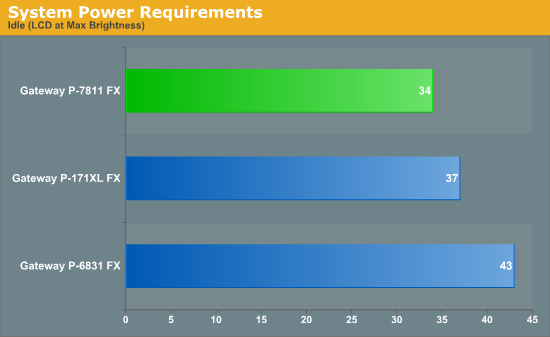
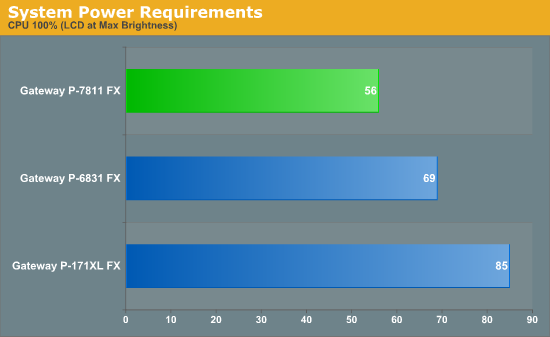
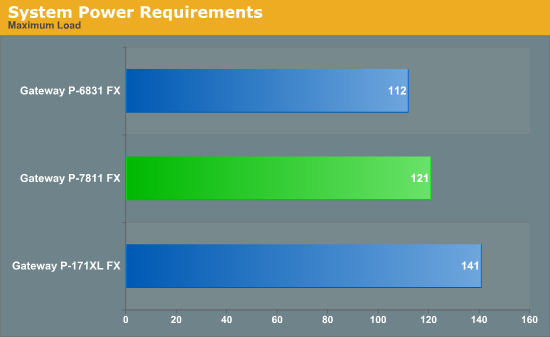
Power draw (measured at the outlet) does indeed drop with the P-7811 relative to the P-6831. The P-171XL really wasn't in the running, given the second hard drive and X7900 CPU. Particularly in the 100% CPU load test, we see a massive benefit from the P8400 and DDR3; the P-7811 uses 13W less than the P-6831 (a 23% difference). In the maximum load test, where we tax both the CPU and GPU, the 7811 does use 9W more than the 6831; that's somewhat expected, however, as you can't generate a maximal GPU load without a faster CPU. In gaming power draw (not shown) the two systems are pretty much tied.
Battery Life
Of course, power requirements when a laptop is plugged in don't necessarily reflect power requirements when a laptop is on battery power. Hardware can provide better performance when plugged in and better battery life when in power saving mode, and the 9800M and P8400 should both provide such an advantage. For our battery life testing, we have now switched to running all laptops at around 100 nits brightness. Differences between displays and brightness adjustments mean we are not always at exactly 100 nits, but the range is 90-110 nits in all cases. If you choose to run your LCD at maximum brightness, you may lose anywhere from 10 to 60 minutes depending on the laptop - the latter is mostly for ultra-mobile options while the former is for gaming notebooks.
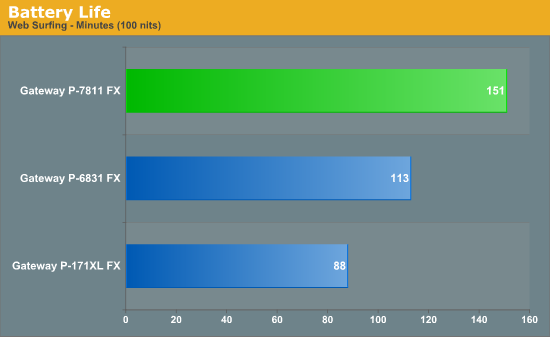
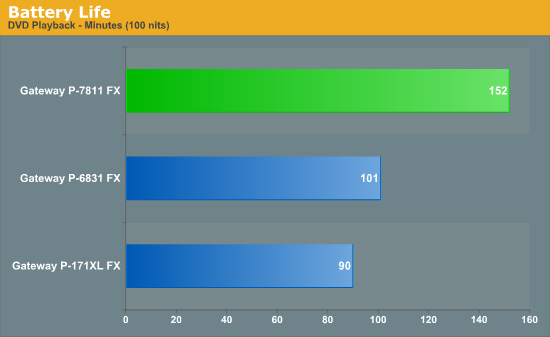
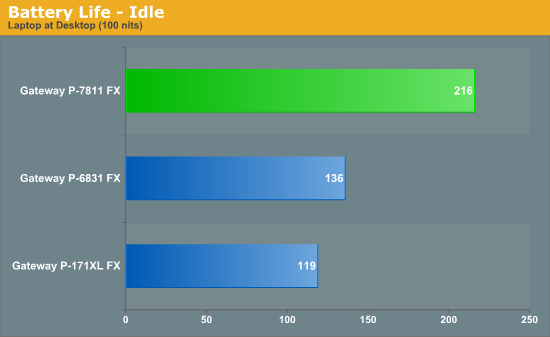
In terms of battery life, the P-7811 shows some significant improvements over the 6831 and 171XL. Clearly, the DDR3 and 25W TDP processor are doing their job, with P-7811 battery life improving by up to 58% over the lower performing P-6831. Our three test scenarios test DVD playback, web surfing (using the wireless adapter), and a best-case idle benchmark where we simply unplug the laptop and let it sit. Keep in mind that even light use of the laptop should reduce the battery life from our idle scenario, so it is purely a high water mark.
With the P8400 (and Centrino 2) offering improved deep sleep states over the previous Santa Rosa refresh, the largest improvements are found in the idle test. DVD playback improves by an equally impressive 50%, and Internet surfing improves by 34%. Two and a half hours of battery life for movies or surfing is certainly nothing exceptional compared to some laptops, but for a gaming laptop it's actually one of the best results we've seen.










45 Comments
View All Comments
JarredWalton - Monday, August 18, 2008 - link
You know, I used to feel the same way, and I still prefer non-glossy desktop displays. On laptops, though, the glossy LCDs frequently look better in terms of color and contrast. I've had the P-171XL and P-7811 sitting next to each other, and the glossy 7811 looks better in pretty much every way. The reflections are annoying at times, but in the right environment I definitely prefer it over a dimmer matte display.rjc - Friday, August 15, 2008 - link
Sorry if i missed it - but was there any temperature info about the different components in the review?Personally own a 8600gt based laptop and the gpu temperatures are terrible, quickly into the 90's celcius as soon as i try to play a game. According to other users(at the notebook-review forums) i can expect this to worsen over time exceeding 100C, the more i play games the quicker the part degrades till it fails.
I didnt pay enough attention to the thermal perf of the laptop when buying, instead distracted way too much the performance graphs like the ones present in the above review. Certainly not going to make that mistake again.
Would the stability issues mentioned in the last page possibly be temperature related rather than a driver issue?
JarredWalton - Saturday, August 16, 2008 - link
When the fan speeds kick up, temperatures are fine, but the P-7811 BIOS appears to need adjustment right now because the fan spins at lower RPMs most of the time. (The 171XL and 6831 didn't have this issue - it could just be a faulty unit as well, as this is prerelease hardware.)Exhaust temps are hitting the 50C range at load on the GPU, and the core is hitting even higher temps. Instability could be heat related, as I mentioned on the concluding page. I'm hoping Gateway can provide a BIOS update so that I can include more details on the final roundup next week. (If you have an 8600M GT hitting 90C, there's definitely a problem with the design or BIOS.)
The roundup will also cover temps in more detail, as well as LCD quality, noise levels, and tests from other competing notebooks. Stay tuned.
rjc - Sunday, August 17, 2008 - link
If the fan speed is upped make sure you redo your battery tests. Both dell and hp have provided fan speed fixes that upped the fan to almost full all the time and users are complaining about the noise and adverse effect on battery life. Also running the fan at full was not the original design and may overheat the fan motor itself causing the fan to prematurely die, likely followed quickly by the whole notebook.The current rumor is something is wrong in the power plane design on the G84/G86 and possibly G92/G94 which causes excessive heating and eventually cracks the surrounding die. Honestly if you somehow can i really recommend investigating this a little, your readers will appreciate it.
There are clues - the nvidia $200m charge, the halving of their share price, the dell and hp announcements. Dell discontinuing their xps line of gaming laptops, and except for quadros dont appear to be selling nvidia gpus at all in notebooks.
Re exhaust temps. I have been measuring core temps with riva tuner. Have upped the fan but it doesnt make much difference 5C tops. The thermal performance is consistent with most other users i can see. Some people have faulty units which run at 10C higher ie over 100C during gaming.
Sorry for going on so much...am just trying to give you the experience of a current "gaming" laptop owner. At the moment i honestly would advise other people to steer clear of these products entirely.
JarredWalton - Monday, August 18, 2008 - link
"The current rumor is something is wrong in the power plane design on the G84/G86 and possibly G92/G94 which causes excessive heating and eventually cracks the surrounding die. Honestly if you somehow can i really recommend investigating this a little, your readers will appreciate it."As far as I can tell, the *rumors* being circulated by some very anti-NVIDIA groups are blowing things way out of proportion. NVIDIA couldn't provide any specific details (because of OEM relations and such), but failing mobile GPUs does not seem to be a rampant problem. I know that personally I have not had a single NVIDIA mobile GPU fail on me or anyone in my family during the past several years, and believe me the stress testing I put laptops through is quite intense.
Yes, there have been failures, but what percent are we talking about? NVIDIA can't say, the OEMs won't say, and you've got a few crazies out there pretending that 90% of mobile NVIDIA GPUs are failing. The actual cause of failures appears to be rapid heating and cooling of the GPU substrate (according to NVIDIA). So a modified fan algorithm is really all that's needed so that temps don't flip back and forth between say 70C and 90C... a constant 80C would be better. (Just guessing on the numbers, though - I didn't get details on temps, again because of OEM concerns.)
Anyway, from what I've heard, the $200M should be way more than is actually needed to address the failed GPUs... and it is only mobile GPUs. Don't put too much in stock prices, as a rumor can cause stock panic whether it is true or just malicious claims from a competitor.
My personal advice is: don't expect desktop performance from a gaming laptop, but if you're willing to spend more for the mobility option there are some decent laptops out there. Right now, I'd take the P-173XL over the P-7811, just because of the stability problems I've experienced, but I think they can fix it easily enough.
rjc - Tuesday, August 19, 2008 - link
"As far as I can tell, the *rumors* being circulated by some very anti-NVIDIA groups are blowing things way out of proportion. NVIDIA couldn't provide any specific details (because of OEM relations and such), but failing mobile GPUs does not seem to be a rampant problem. I know that personally I have not had a single NVIDIA mobile GPU fail on me or anyone in my family during the past several years, and believe me the stress testing I put laptops through is quite intense. "There is an article in the WSJ today:
http://online.wsj.com/article/SB121910081640451139...">http://online.wsj.com/article/SB121910081640451139...
As the article mentions HP and Dell have both extended their warranties specially to cover this. The analyst says that $200m might not be enough to cover it.
Roughly doing the maths at $400 per repair $200m will cover 500k repairs...As nvidia sold around 30m units last year thats 1 in 60 replaced. Of course if the OEM is covering part of the cost the failure rate is likely higher.
I realise when doing reviews the fun bit is all the performance figures, how many frames you get for your $....some time spent on less attractive things like how good the warranty is, ease of rma process and whether the system can run in a stable state for long periods would better help customers make a decision they are later happy with.
As long as your sure you are not selling them a lemon ;-)
disorder - Friday, August 15, 2008 - link
For people that are interested in a bargain, I've seen the P-6831 at a little over $1000 at some Chicago area BBs. It has been discontinued because the P-7811 has shipped.Rekonn - Friday, August 15, 2008 - link
Thanks for an excellent review!rvikul - Friday, August 15, 2008 - link
Any comment on the overall build quality of these Gateway laptops? I am considering getting one of the gaming laptops and durability/build quality is my primary concern.I own an eMachines (later acquired by Gateway) laptop and it developed a crack within a few months on the back just under the screen.
Thanks
JarredWalton - Friday, August 15, 2008 - link
Overall build quality seems good but not great. It's still a plastic chassis, so if you drop it or something it could break. I do know some people with a 6831 that have used it for the past ~6 months with no problems.